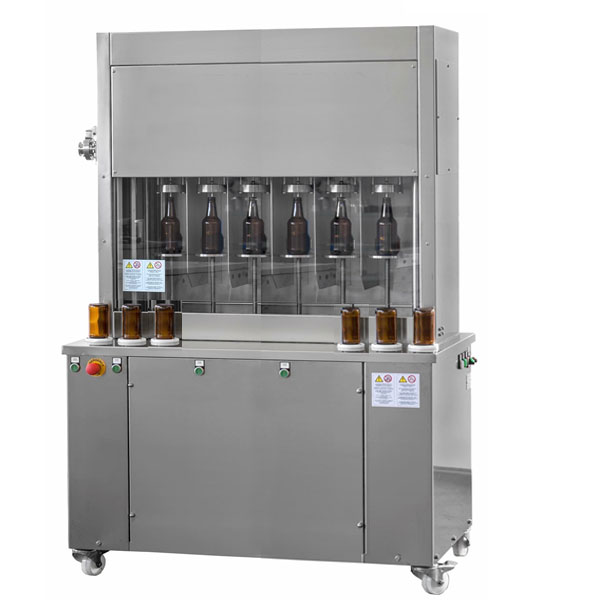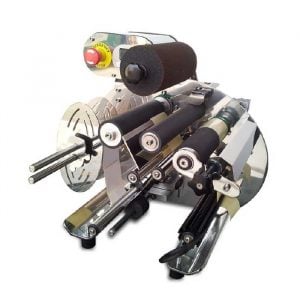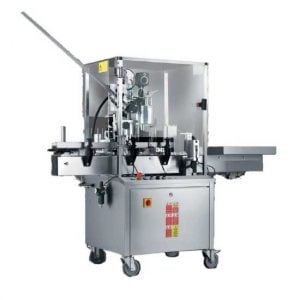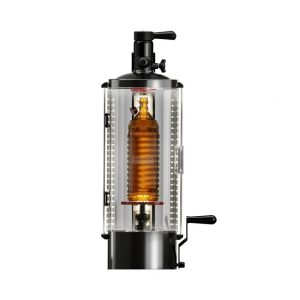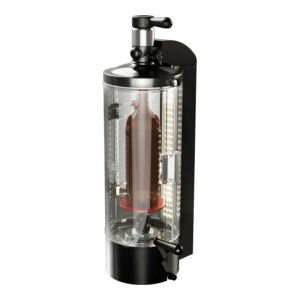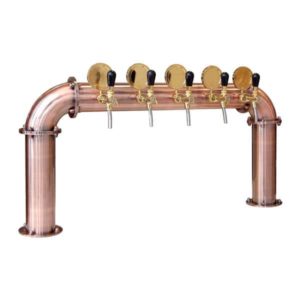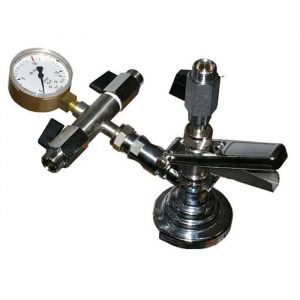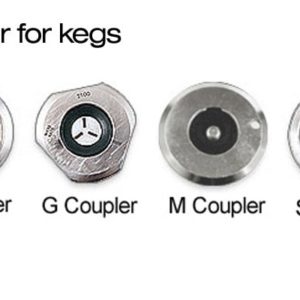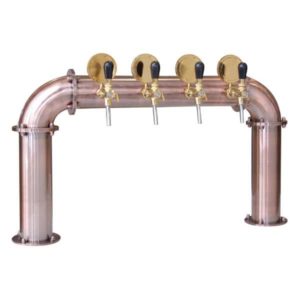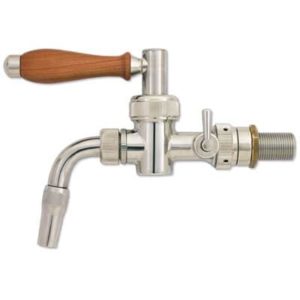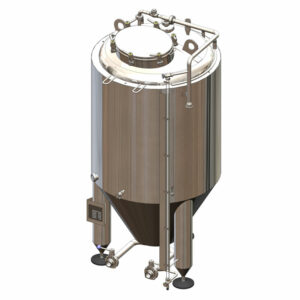Description
Compact bottling machine with two integrated units :
- semi-automatic rinsing the glass bottles (optionally PET bottles or cans) – 6 electronic valves
- isobaric filling the glass bottles (optionally PET bottles or cans) – 6 electronic valves
with electronic valves, optionally adaptable for aluminium cans or PET bottles.
Production speed : from 450 up to 600 bottles per hour (depending on the operator, product, temperature, foamicity, pressure)
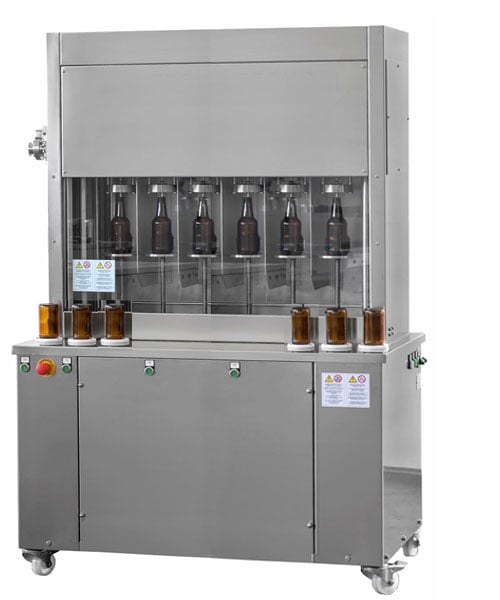
Technical parameters
| Maximal operation capacity | from 450 up to 600 bottles per hour (depending on the operator, product, temperature, foamicity, pressure) |
| Number of : rinsing valves/filling valves/capping heads | 6/6/0 |
| Height of the worktable | 750 cm |
| Max. bottles size : diameter / height | 120mm / 350mm |
| Max. cans size : diameter / height | 70mm /180mm |
| Power connection | 220-240V 50/60 Hz single phase |
| Electrical consumption | 0.75 kW/h |
| Max filler tank pressure | 5 bar/72 psi(tested on 9 bar/130 psi ) |
| Compressed air consumption | 120 lt/min 7 bar |
| Beverage product pipe connection | DIN 32676 TRICLAMP D=51mm (other types on request) |
| CO2/N2 connection | John Guest 8mm or Female G 3/8” gas |
| Compressed air connection | John Guest 8mm or Female G 3/8” gas |
| Sterile water connection | Female G 1/2” / 3.5 bar |
| Maximum rinsing temperature | 60°C / 140°F (on request 85°C / 185°F) |
| Filler tank material | AISI 304 (filling valves AISI 316) |
| Beverage products | Beer, sparkling water, wine, soft drinks |
| Cans type | All common types defined by customer (available only with an optional adaptation kit) |
| Dimensions | WxDxH : 2100 x 435 x 2300 mm |
| Weight Net | 800 kg |
Description :
The machine is manufactured of stainless steel and food-friendly plasts of different thicknesses.
Construction is on four lockable wheels for easy transfer of the machine.
This two-block machine has been designed to assist in filling carbonated or non-carbonated beverages in glass bottles with crown caps. Two phases of bottling process in one compact block with a steel base on wheels. Rinsing + filling
1st section : rinsing the bottles (or cans)
- Six rinsing positions
- Rinsing six bottles in the same time (in standard)
- Rinsing six cans in the same time (only with optional equipment)
- 1st rinsing cycle (in standard) : one-way water
- 2nd rinsing cycle (only with optional equipment) : recirculating solution (for example alkaline sanitizing solution)
- 3nd rinsing cycle (only with optional equipment) : one-way water (for example sterile water)
- 4rd rinsing cycle (only with optional equipment) : recirculating solution (for example sterilizing solution based on alcohol)
- 5th rinsing cycle (only with optinal equipment) : sterile air (drying the bottles)

2nd section : filling the bottles (or cans)
- Six filling positions
- Isobaric filling of carbonated beverage into six bottles in the same time (in standard)
- Gravity filling of non-carbonated beverage into six bottles in the same time (in standard)
- Filling beverages into glass bottles (in standard)
- Filling beverages into PET bottles (only with optional equipment)
- Filling beverages into aluminium cans (only with optional equipment)
- The filling process takes place automatically, the operator only has to place all the bottles on the supports and remove them in the end of the process
- Pre-evacuation (only with optional equipment) : First the single or double pre-evacuation of oxygen is carried out inside the empty bottles, by means of an external vacuum pump
- The second pre-evacuation of oxygen is preceded by a CO2 injection, in order to lift the rest of oxygen to the upper part of the bottle.
- This system guarantees an excellent result in terms of dissolved oxygen – less than 28 PPB is reached in beverage in the bottles.
- At the end of the bottle filling process, the pressure compensation occurs between the bottle and the isobaric tank, and the beverage flowes up to the level of the level devices.
- The type of deflector installed determines the correct flow while measures a level through the walls of the bottle.
- The level of product inside the bottles is determined by the interchangeable devices depending on the capacity of the bottle and the level height required.
- In the last phase, the bottles are de-pressurized, controlled by an opening and closing timer in order to gently release the pressure and avoid extremely foaming.
- The controlled creation of a foam avoid entering of the oxygen in the bottles before they are closed.
- By modifying the depressurization times, the operator can set more or less foam.
a) Filling the glass bottles
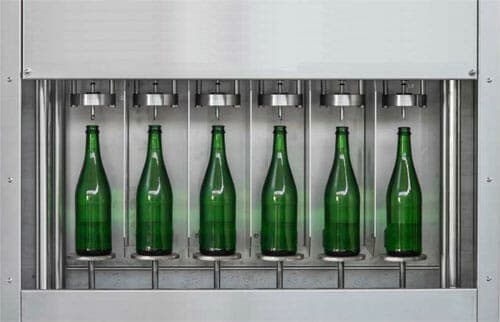
b) Filling the PET bottles
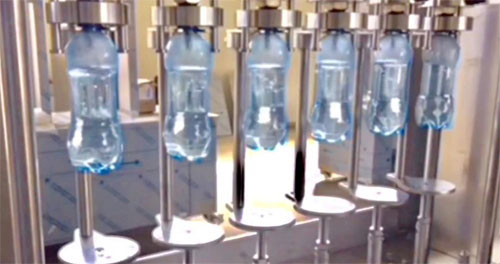
c) Filling the aluminium cans
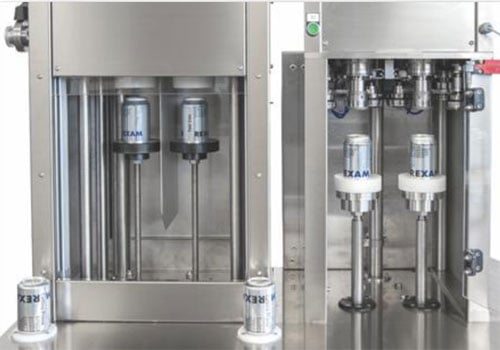
Operating cycle:
- Rinse the isobaric tank with ice water to reduce the temperature in the tank to achieve reduce foaming.
- Fill the source tank with a beverage intended to be filled into the bottles.
- Remove the air from the tank by carbon dioxide.
- Place the bottles in the rinsing positions.
- Activate the bottle rinsing process by a switch on the PLC control panel.
- Place the bottles in the filling positions.
- Activate machine by means of a safety switch on the PLC control panel.
- Safety glass door is automatically closed (pneumatically driven).
- The bottles are lifted pneumatically under the filling valve.
- The vacuum system sucks air out of the bottle.
- The machine fills bottles with carbon dioxide from the external CO2 pressure bottle (not from a filling tank).
- The vacuum system sucks air out of the bottle.
- The machine fills the bottles with carbon dioxide from the external CO2 pressure bottle (not from the filling tank)
- The vacuum system sucks air out of the bottle.
- The machine achieves pressure stability and starts the filling beverage into the bottles.
- The machine lowers the level of pressure.
- The bottles are moved down from the filling valves.
- Remove the bottles out from the machine.
BFSA-MB660 machine consists of :
| DESCRIPTION | EURO |
|---|---|
| MAIN EQUIPMENT |
|
| BFSA-MB660 Semi-automatic 6-6-0 rinsing and filling for bottles (counter pressure filling) | Price on demand |
| OPTIONAL EQUIPMENT |
|
| I. OPTIONAL EQUIPMENT FOR THE RINSING UNIT | |
| Machine without the rinser unit | Price on demand |
| System for cleaning solution recirculation in the rinsing unit | Price on demand |
| II. OPTIONAL EQUIPMENT FOR THE FILLING UNIT | |
| Single pre-evacuation of air from the bottles with external vacuum pump | Price on demand |
| Double pre-evacuation of air from the bottles with external vacuum pump | Price on demand |
| Dummy bottles with continuous flow – Special CIP system for high level cleaning process and chemical solution return exhaust to your CIP unit | Price on demand |
| Automatic cycles – Automatic timing and switching between all cycles (programmable by user using PLC and display) | Price on demand |
| Automatic sliding door protection on the filling unit | Price on demand |
| Non-return valve with TriClamp 1 inch connections | Price on demand |
| CIP collector for chemical solutions – hose manifold (see a scheme bellow) | Price on demand |
| Cans centering (Slim or Standard) | Price on demand |
| Complete set of replaceable seals for all 6 filling valves | Price on demand |
| Additional filling tubes, for different types of the bottles | Price on demand |
| Accessory kit for the filling of PET bottles | Price on demand |
| Product loading kit AISI 304 – Pneumatic diagphragm pump AISI 304 with connections TriClamp 1 inch | Price on demand |
| Product loading kit AISI 316 – Pneumatic diagphragm pump AISI 304 with connections TriClamp 1 inch | Price on demand |
| Big bottles centering (for use very big bottles) | Price on demand |
| Beverage product hose sterilizable with hot steam (TriClamp connectors) | Price on demand |
| Construction parts in contact with the beverage product made of AISI 316 (necessary for cider) | Price on demand |
| CO2 injection into the bottle: before capping of the bottles | Price on demand |
| 50 liters tank AISI 304 with all pipe and hose connections to filling machine | Price on demand |
| III. OPTIONAL EQUIPMENT AND SERVICES – OTHERS | |
| ROM Software recovery | Price on demand |
| Shipping cost including packing | not included |
| Special voltage including UL conformity electronic parts (American market) | Price on demand |
| Installation work provided by our specialist – each day (does not include hotel/dinner/lounch and travel expenses) | Price on demand |
| Packing costs – wooden crate with chemical protection for transport over sea | Price on demand |
| Packing costs – wooden crate (normal, transport to EU area) | Price on demand |
| Packing costs – wooden crate when more devices will be packaged | price on demand |
| Delivery & insurance (only Europe) | price on demand |
| TOTAL – (for EUROPE) | price on demand |
I. CIP setup – cleaning and sanitizing of the compact bottling machine
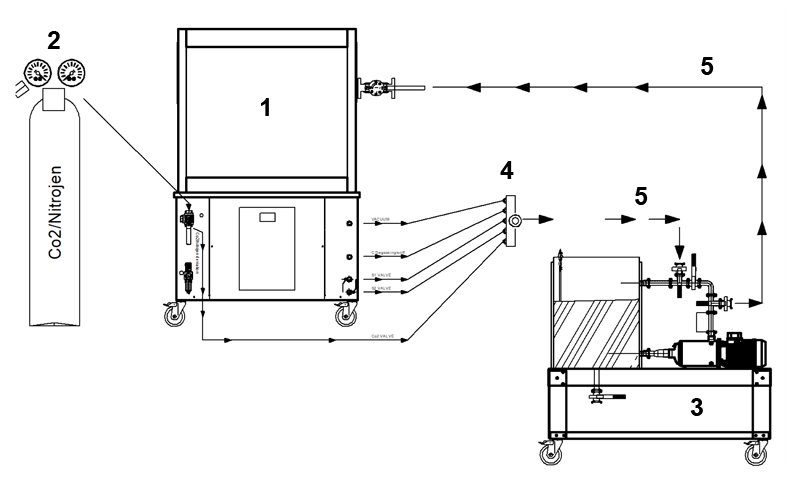
Description :
- Compact bottle filling machine
- Bottle with pressure carbon dioxide and reduction valve
- CIP station – we recommend use the machine CIP-52 or CIP-53
- CIP collector for chemical solutions (see optional equipment table)
- Hoses for connection between the CIP station and the compact bottle filling machine
II. Dummy bottles setup for CIP (in motion)
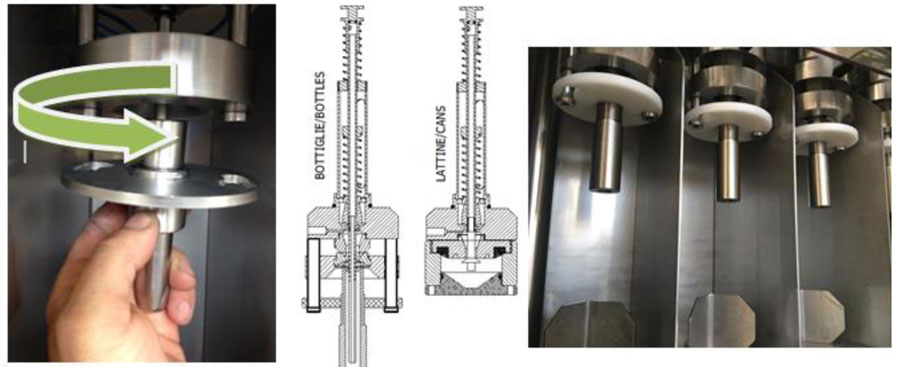

III. Dummy bottles – set for high pressure CIP operation (in motion)
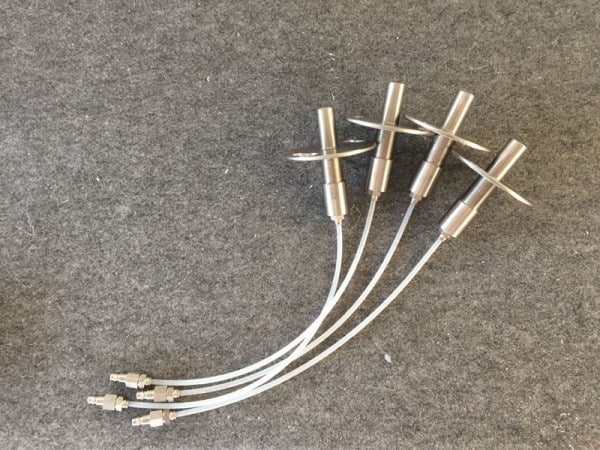
Connections :
I. Filling carbonated beverages from a pressure tank
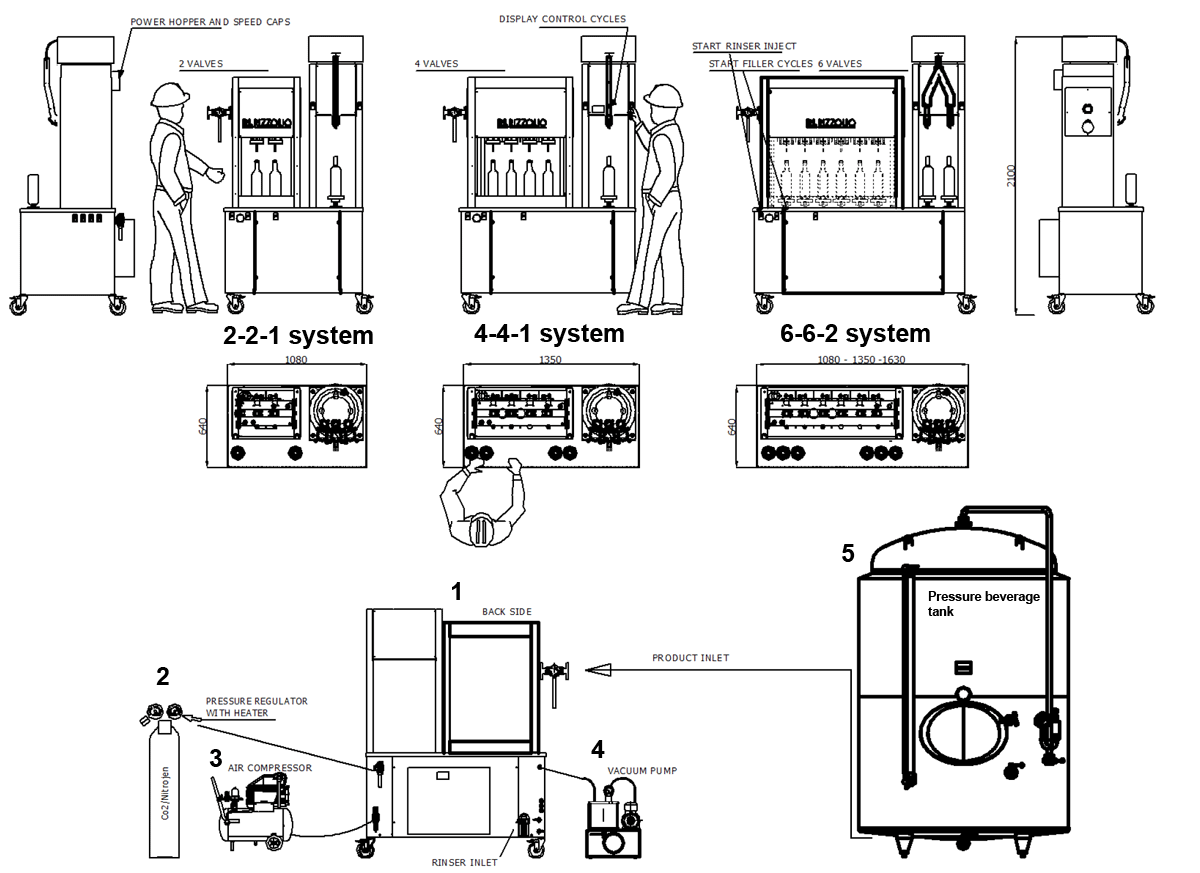
Description :
- BFSA-MB bottling machine
- Pressure bottle with carbon dioxide and reduction valve
- Air compressor (needed for powering the pneumatic valves and actuators)
- Vacuum pump (needed for pre-vacuation the bottles)
- Pressure tank with carbonated beverage
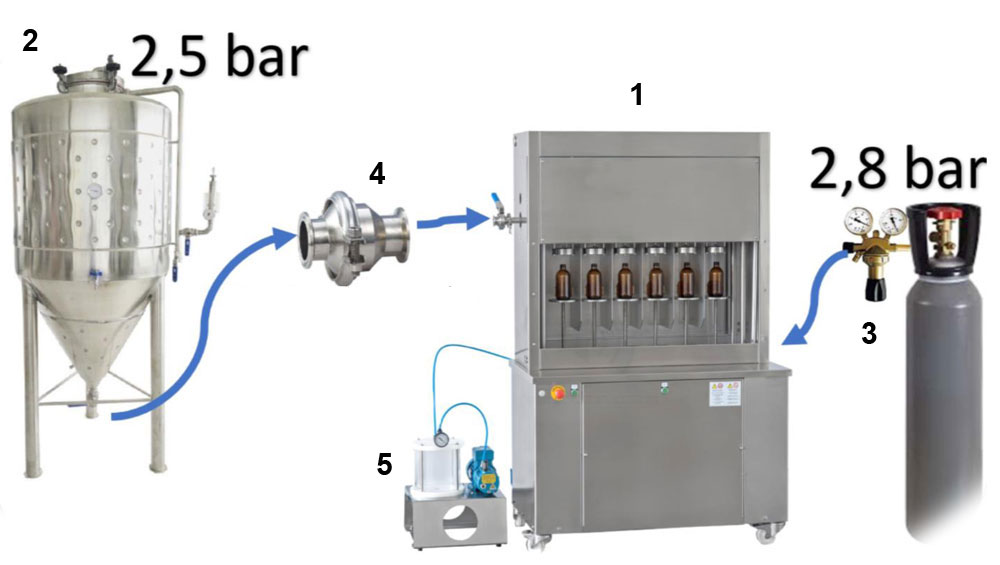
Description :
- BFSA-MB bottling machine
- Pressure tank with carbonated beverage
- Pressure bottle with carbon dioxide and reduction valve
- Non-return valve
- Vacuum pump
- Blue lines – pressure hoses
II. Filling non-carbonated beverages from a non-pressure tank
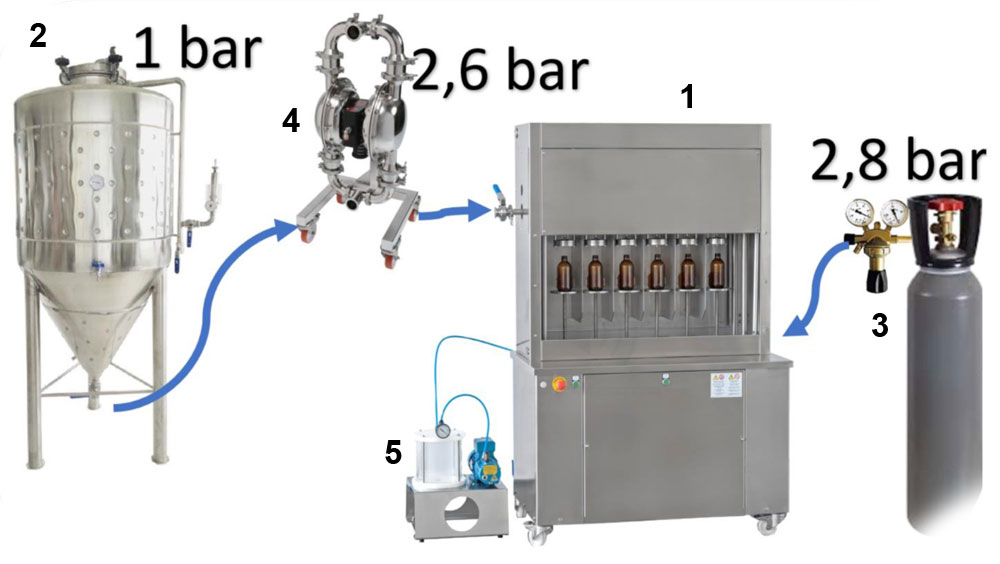
Description :
- BFSA-MB bottling machine
- Pressure tank with non-carbonated beverage
- Pressure bottle with carbon dioxide and reduction valve
- Pneumatic diagphragm pump
- Vacuum pump
- Blue lines – pressure hoses
All connections and inputs :
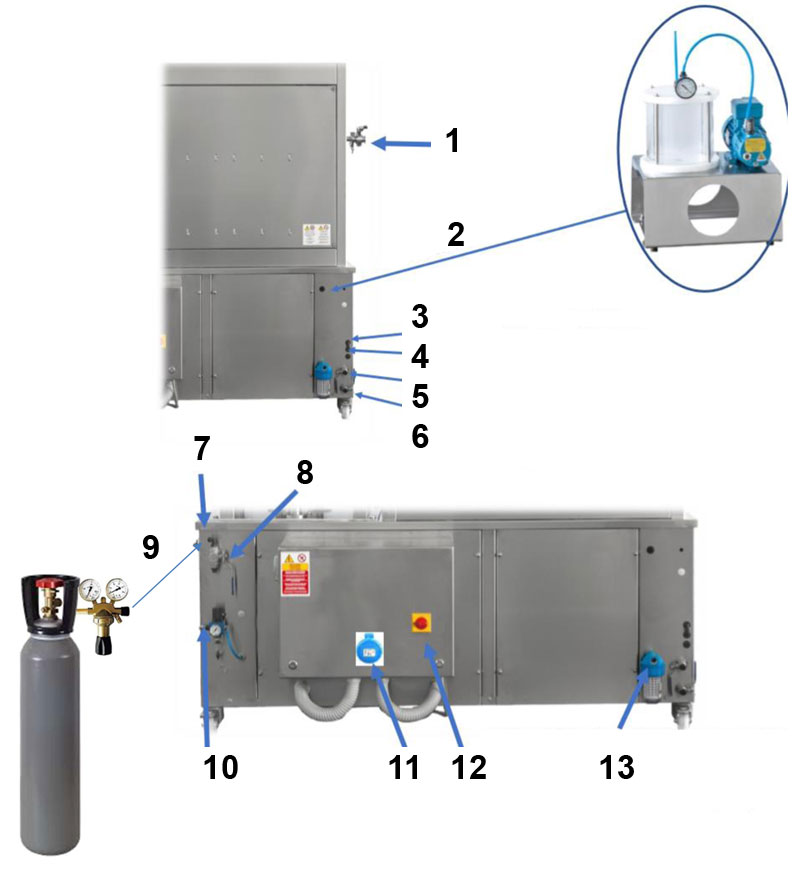
Description :
- Beverage product inlet ( DIN 32676 “TriClamp” Ø 51 mm )
- Vacuum pump connection (beverage hose Ø 8 mm – John Guest couplers)
- CO2 exhaust for the bottle decompression (beverage hose Ø 8 mm – John Guest couplers)
- Water outlet for the rinsing cycle (beverage hose Ø 8 mm – John Guest couplers)
- Outlet CO2 – venting valve of the high level filling (beverage hose Ø 8 mm – John Guest couplers)
- Outlet CO2 – venting valve of the low level filling (beverage hose Ø 8 mm – John Guest couplers)
- Inlet CO2 or N2 from the pressure bottle under maximal pressure 5 bar (beverage hose Ø 8 mm – John Guest couplers)
- Water outlet (beverage hose Ø 8 mm – John Guest couplers)
- CO2 hose between the pressure bottle with the reduction valve and the bottling machine
- Inlet of compressed air min. 5 bar 120 L/min. (pressure hose Ø 10 mm – John Guest couplers)
- Vacuum pump electric socket – for removing oxygen from the bottles
- Power switch for the electric socket
- Water inlet – G 1/2 inch female hose connector (maximal pressure 4 bar)
Semi-automatic control system :

Description :
- Start of choosed cycle
- Emergency stop button
- Programmable unit with a display
Automatic cycles (see optional equipment table) facilitates all the operations of the bottle rinsing, filling steps and capping. You can choose different types of the filling process.
Available modes and their settings
I. Bottle rinsing mode :
- Injection timer – editable timing of the automatic valves
II. Bottle filling mode :
- Standard
- Single pre evacuation with CO2 injection timer adjustable
- Double pre evacuation with double CO2 injection timer adjustable
- CO2 purge for remove the oxygen in the PET bottles and cans before the capping cycle
- You can change the time of the pre-evacuation, time of CO2 injection, time of the degassing
III. CIP mode :
- Opening all valves for the cleaning and sanitizing the machine using a CIP station
IV. Degassing mode :
- Opening and closing the valves when decompressing according on timer setting in two or more steps.

